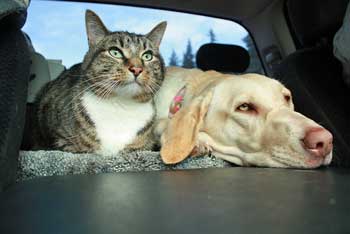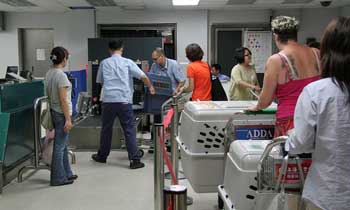More than 56 million households in the United States have at least one dog, and over 45 million households have at least one cat. Considering the number of Americans that travel each year, chances are high that at least some of these people are going to want to take their pets with them instead of leaving them at a kennel or even at home with a family member or pet sitter.
Perhaps you are one of those people, wondering how you are going to take your dog on vacation to see the Grand Canyon or your cat to visit your family in New York? We have good news for you. You have options, some of which are quite budget friendly.
Please note that the travel restrictions in this article excludes service dogs, which are specially trained dogs to support a person with a disability, and are legally allowed anywhere with their person.
Options are in order from cheapest to most expensive.
Taking your pet on public transportation (Includes boat/ferry/train/bus) can be the most budget-friendly
Public transportation is generally pretty restrictive, and it can be difficult to find information, so it would be a good idea to call the specific company before showing up with your small pet. If the company does allow pets, it is usually only a small pet, in a carrier on your lap. The good news is that they are allowed at no fee, making it the cheapest option for travel.
The downside to public transportation
The two bigger names in train and bus travel, Amtrak and Greyhound, currently do not allow pets beyond service dogs, and as stated above, public transportation in general can be very restrictive.
Taking a pet on a long car trip
 A car is pretty easy – pack it up, throw everybody in, and go. The downside is that cars can get cramped, some pets get carsick, and there is a very real health risk to leaving your pet in the car, even if the outside temperature is only 60 degrees!
A car is pretty easy – pack it up, throw everybody in, and go. The downside is that cars can get cramped, some pets get carsick, and there is a very real health risk to leaving your pet in the car, even if the outside temperature is only 60 degrees!
The perks of traveling in a car
The best part is that you have the freedom to stop as much as you want along the way for potty and hydration breaks, but unless you are camping, you will have to find a pet-friendly hotel and pay those pet fees (hotels usually charge at least an additional fee per night for each pet, have restrictions on number of dogs and the size of dogs, and may also require a cleaning deposit).
Preparing your pet and vehicle
 You may also want to consider a pet seatbelt/harness/car seat. The safest way to travel in the car is in a crate, but there are some other options out there that add to the cost consideration. As far as safety goes, a loose dog becomes a dangerous projectile in the event of an accident, which is not safe for you or for your dog, so it is definitely a worthwhile expense.
You may also want to consider a pet seatbelt/harness/car seat. The safest way to travel in the car is in a crate, but there are some other options out there that add to the cost consideration. As far as safety goes, a loose dog becomes a dangerous projectile in the event of an accident, which is not safe for you or for your dog, so it is definitely a worthwhile expense.
Things to be careful of
If your dog doesn’t ride in the car that often, take him on some rides before throwing him into a 8+ hour day of driving. You may also want to feed him less than usual, and if your dog seems to have some real anxiety (not wanting to get into the car, panting, general looks of discomfort), try giving him a toy or something to chew on in the car, as well as trying a natural supplement before he gets in the car (such as ProQuiet or Rescue Remedy).
Taking your pet on an RV vacation
 If you are renting an RV already, the two big rental companies (Cruise America and El Monte) allow an unrestricted number of pets, regardless of size, and don’t charge a deposit initial upfront fee, but may charge a cleaning fee if your pet makes a mess.
If you are renting an RV already, the two big rental companies (Cruise America and El Monte) allow an unrestricted number of pets, regardless of size, and don’t charge a deposit initial upfront fee, but may charge a cleaning fee if your pet makes a mess.
Cruise America’s cleaning fee is currently $250 while El Monte’s cleaning fee is just $50.
Save money in hotel pet fees
This could be a great budget option. You would save money because you wouldn’t be staying in a hotel and paying the extra fees for a pet-friendly hotel (hotels usually charge at least an additional fee per night for each pet, have restrictions on number of dogs and the size of dogs, and may also require a cleaning deposit).
RV comfort and safety bonuses
This could also be a great option for the comfort and safety of your pet if you are traveling to places where dogs are not allowed, or if you decide to stop at a restaurant along the way – you don’t have to worry about leaving your dog in a hotel room or a hot/cold car.
As with humans, an RV gives your dog more room to move around, and is likely more comfortable than being cramped in a car. You can bring your pet’s bed and toys, and set up a homier environment that will help your pet feel more comfortable.
Just like in a car, you have the freedom to stop as much as you want along the way, which is great for potty breaks! I would recommend checking out some trails or dog parks along your path to give your pup an extra romp if needed!
Commercial Airlines: A more expensive option
Not only are airlines a more expensive option, they are not the safest option for your pet, especially if you have an older pet, or a breed with a shorter, stubbier nose.
Most airlines will not allow pets with shorter noses, such as Pugs or Boston Terriers, to travel if the temperature/humidity reaches a certain point, which can certainly put a damper in your travel plans.
Adding up the pet fees
 Most major airlines allow pets, and prices range from $75 – $220 each way, with some charging more if your pet is over a certain weight For a complete list, check out Dog Friendly’s lists.
Most major airlines allow pets, and prices range from $75 – $220 each way, with some charging more if your pet is over a certain weight For a complete list, check out Dog Friendly’s lists.
If your pet cannot fit comfortably in a carrier under the seat, he or she will have to ride in the cargo, which is not the safest place for your pet, but can be made safer with these tips from the Humane Society of the United States.
Besides the ticket fee, there are several other costs to consider with air travel:
- Carrier – Can be as inexpensive as $30 for a mesh in-cabin carrier, but most airline approved cargo kennels start around $50 for medium to large size pets. It is possible to find a cargo kennel for a small dog for closer to $20.
- Health Exam and Certificate – An exam by your vet + health certificate (required within 10 days of travel) + updating any shots, micro chipping if necessary + updating tags with your current address if necessary.
- Not all flights are ideal – You may need to book a flight with some special considerations in mind, which may not allow you to get the cheapest price. Some of these considerations might be a non-stop flight, when the temperature is warm, choose an early morning/late evening flight, when the temperature is cold, choose a mid-day flight.
Things to consider when traveling to another country
If you are traveling internationally, there may be quarantines in place either at your destination, or when you return to your home country. For a great list of suggestions and requirements for just about every country in the world, visit PetTravel.com (International travel – http://www.pettravel.com/passportnew.cfm).
Sadly, the only company that offered main cabin flights just for animals, went out of business.
Shipping your pet via ground transportation
You can ship your pets to your destination via ground transportation, which will require the health certificate, an approved carrier, and possibly permits and/or export/import permit.
Safer for your pet than flying
This is probably more safe than flying simply because there are not as drastic altitude and temperature changes, but can cost hundreds of dollars, making it more expensive than flying your dog. For more information or to find a shipping company, visit the International Pet and Animal Transportation Association.
Other things to consider before traveling with your pet
First and foremost, regardless of how you are traveling, is your pet healthy enough for the trip? Does your pet enjoy being in the car or would he/she be more comfortable just staying at home?
Be sure to talk about your travel plans with your veterinarian, and make sure there aren’t any additional vaccinations you should get for your pet. On that note, be sure your pet’s vaccinations are up-to-date, and keep a copy of the records with you and a copy with your pet, if you are traveling separately.
Figure out pet–friendly hotels ahead of time so you aren’t scrambling to find one at the last minute. You may also want to plan some potty breaks and good places for your pup to explore and get some exercise – it won’t hurt to stretch your legs, either.
We are lucky to live in a time when pets are becoming more like family members, so those of us that love our pets and love travel, don’t have to choose one over the other. There are some great options for bringing Fido or Fifi along for the fun!
Have you traveled with your pet? What methods would you recommend?
Additional Resources:
American Veterinary Medical Association
Photo credits: RV and dog by Kathryn Decker on Flickr, cat and dog by tmst23 on Flickr, Vuitton dog by Lovro Rumiha on Flickr, dog in car by Taro the Shiba Inu on Flickr, pet carriers by ilovemytank on Flickr
By Abbie Mood
Abbie lives just outside Denver, CO and can usually be found hanging out with her dogs, Daisy and Sadie. In addition to freelance writing and editing, Abbie is a dog trainer and an early interventionist for children birth – 3 years with special needs. You can find more of her writing on her blog, Miles of Abbie.

Comment*I’m trying to get to Myrtle Beach in SC from Pennsylvania I’m on a budget how much will it cost me and my dog
Patricia,
I’m not sure how much I can help you with that, but I can recommend an app called Bring Fido. It lists all of the hotels that allow dogs and shows their pet policies and fees. Good luck! -Roger
How can I travel with my dog to North Dakota, Starting a new life.
This is one of the saddest comments I’ve seen. Where are you starting from? -Roger